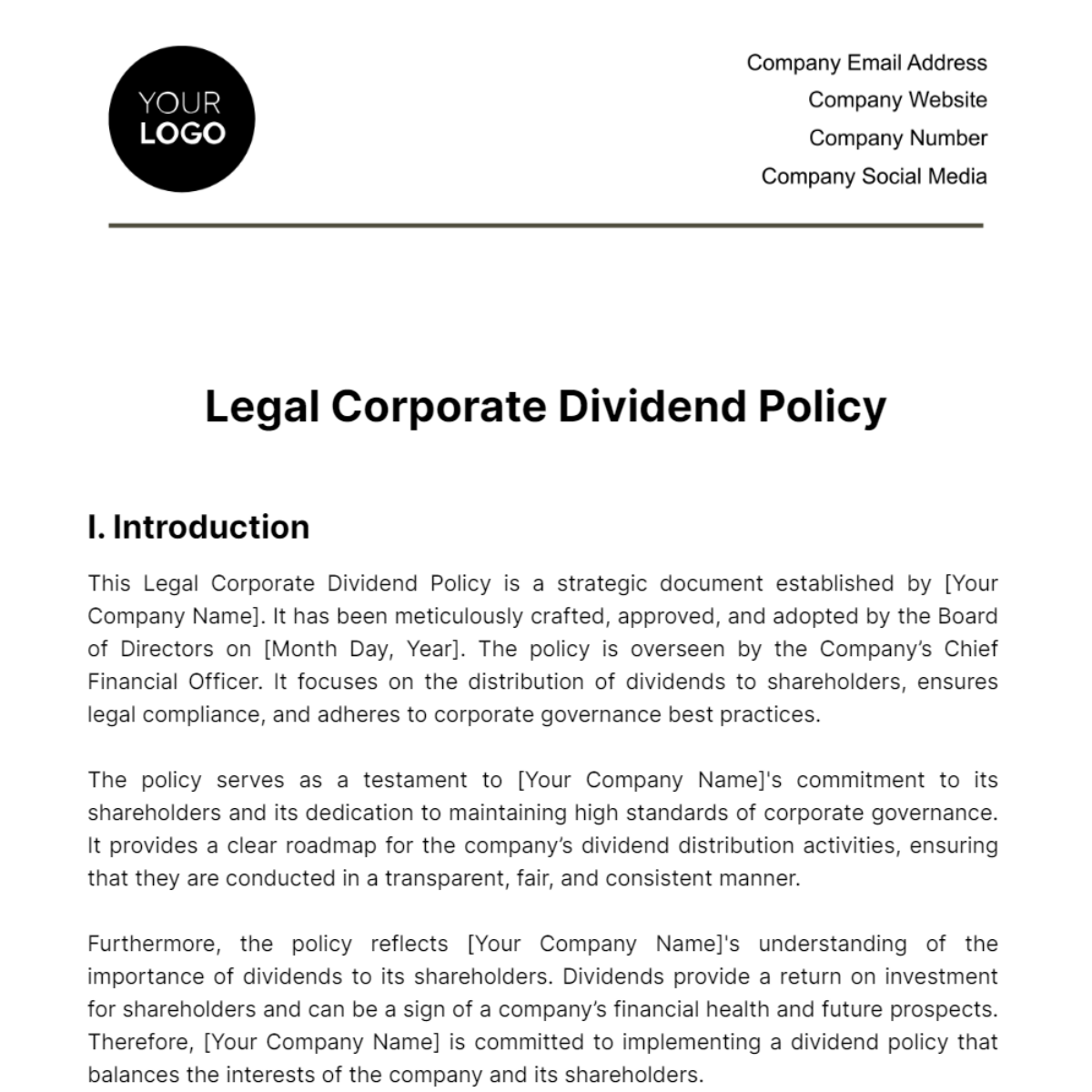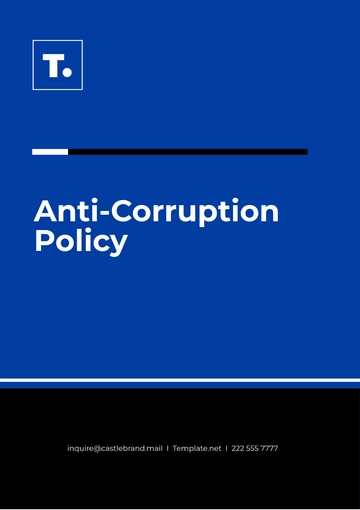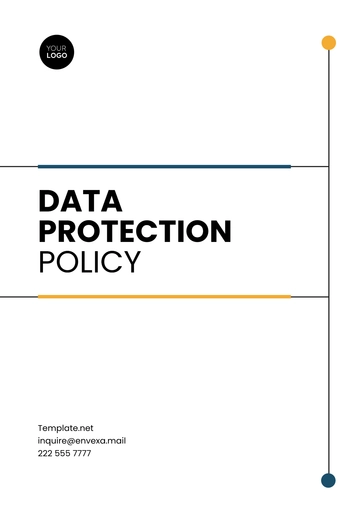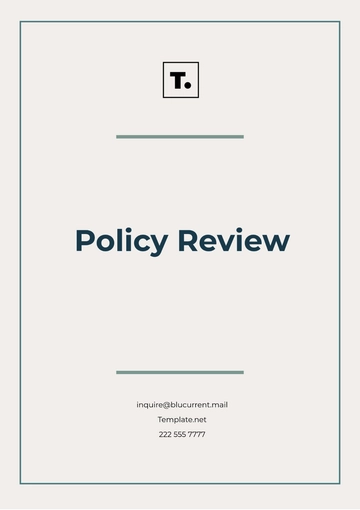Free Legal Corporate Dividend Policy

I. Introduction
This Legal Corporate Dividend Policy is a strategic document established by [Your Company Name]. It has been meticulously crafted, approved, and adopted by the Board of Directors on [Month Day, Year]. The policy is overseen by the Company’s Chief Financial Officer. It focuses on the distribution of dividends to shareholders, ensures legal compliance, and adheres to corporate governance best practices.
The policy serves as a testament to [Your Company Name]'s commitment to its shareholders and its dedication to maintaining high standards of corporate governance. It provides a clear roadmap for the company’s dividend distribution activities, ensuring that they are conducted in a transparent, fair, and consistent manner.
Furthermore, the policy reflects [Your Company Name]'s understanding of the importance of dividends to its shareholders. Dividends provide a return on investment for shareholders and can be a sign of a company’s financial health and future prospects. Therefore, [Your Company Name] is committed to implementing a dividend policy that balances the interests of the company and its shareholders.
II. Purpose of the Policy
The purpose of this policy is to articulate [Your Company Name]'s philosophy on dividend distributions. It aims to ensure transparency and provide clarity to its shareholders and other stakeholders.
A. Transparency
The policy is designed to provide clear and transparent information about [Your Company Name]'s approach to dividend distribution. It outlines the factors that influence dividend decisions and the process by which dividends are determined and distributed. This transparency helps to build trust between the company and its shareholders and other stakeholders.
The policy also provides transparency about the company’s compliance with legal and regulatory requirements related to dividend distribution. This reassures shareholders and other stakeholders that [Your Company Name] is committed to operating in a lawful and ethical manner.
Furthermore, the policy provides transparency about the roles and responsibilities within the company related to dividend distribution. This helps shareholders and other stakeholders understand who is involved in dividend decisions and how these decisions are made.
B. Clarity to Shareholders
The policy provides shareholders with a clear understanding of when and how dividends will be distributed. This helps shareholders plan their investments and manage their expectations about dividend income.
The policy also provides clarity about the company’s dividend determination process. It explains the factors that the company considers when deciding on the amount of dividends to distribute. This helps shareholders understand the company’s dividend decisions and the factors that influence these decisions.
In addition, the policy provides clarity about the forms of dividends that the company may distribute. This helps shareholders understand what they can expect to receive as dividends.
III. Dividend Determination
The determination of dividends is a critical aspect of [Your Company Name]'s financial strategy. The Board of Directors (“the Board”) plays a pivotal role in this process. They take into account a multitude of factors including the Company’s profitability, future expansion plans, capital expenditure requirements, and other relevant factors. This comprehensive approach ensures that the dividend determination process aligns with the company’s overall strategic objectives and financial health.
The following table outlines the key factors that the Board considers when determining the dividend payout:
Factor | Description |
|---|---|
Profitability | The company’s current and projected profitability. |
Future Expansion Plans | The company’s plans for future growth and expansion. |
Capital Expenditure Requirements | The company’s need for capital to fund its operations and investments. |
Other Relevant Factors | Other factors that may impact the company’s financial position or its ability to pay dividends. |
Profitability is a key determinant of the company’s ability to pay dividends. A profitable company generates surplus funds that can be distributed to shareholders as dividends. However, the Board must also consider the company’s future financial prospects. If there are concerns about the company’s future profitability, the Board may decide to retain more profits and distribute fewer dividends.
Future Expansion Plans also influence the dividend payout. If the company plans to expand its operations or enter new markets, it may need to retain more of its profits to fund these initiatives. The Board will consider the company’s strategic plan and its future expansion plans when determining the dividend payout. This ensures that the dividend payout is aligned with the company’s strategic objectives and its long-term growth plans.
Capital Expenditure Requirements are another important consideration. The company needs to retain sufficient capital to fund its operations and investments. If the company has significant capital expenditure plans, it may need to retain more of its profits, which could result in lower dividends.
Moreover, other Relevant Factors such as the company’s debt levels, its cash flow, and the overall economic environment can also impact the company’s dividend policy. These factors can affect the company’s financial position and its ability to pay dividends.
In summary, the determination of dividends is a strategic decision in the company’s financial management. It impacts the company’s relationship with its shareholders, its financial stability, and its capacity for future growth. By considering a range of factors, the Board ensures that the company’s dividend policy is robust, sustainable, and aligned with the company’s strategic objectives.
IV. Frequency of the Distribution
A. Annual Distribution
An annual dividend distribution aligns with the company’s financial reporting cycle, allowing the Board to make informed decisions based on the company’s annual financial performance. This frequency provides a regular and predictable income stream for shareholders, which can be particularly beneficial for those who rely on dividends for a portion of their income.
However, the exact timing of the annual dividend distribution may vary from year to year, depending on factors such as the company’s cash flow position, its profit levels, and its future capital requirements. The decision to distribute dividends annually is also influenced by the company’s long-term strategic goals, market conditions, and the need to maintain a balance between rewarding shareholders and reinvesting in the business.
B. Board’s Discretion
While the typical frequency is annual, the exact timing and amount of dividend distributions are ultimately at the Board’s discretion. This allows the Board to respond flexibly to changes in the company’s financial position or the broader economic environment. The Board’s discretion in determining the frequency of dividend distribution is guided by the company’s dividend policy, its strategic objectives, and its commitment to acting in the best interests of its shareholders.
The Board’s decisions on dividend distribution are made following careful consideration of a range of factors, including the company’s profitability, its cash flow position, its future capital requirements, and its legal and regulatory obligations. The Board also considers the expectations of shareholders and the market sentiment towards dividends. It strives to make decisions that are in the best interest of the company and its shareholders, while also being mindful of market trends and expectations.
V. Forms of Dividend
Dividends may be declared and paid in cash or via issuance of additional shares of the Company, subject to the approval of shareholders at the Company’s Annual General Meeting.
A. Cash Dividends
Cash dividends are a direct way to distribute profits back to shareholders. They provide immediate value to shareholders and can be particularly attractive to income-focused investors. However, cash dividends reduce the company’s cash reserves, which could otherwise be used for reinvestment in the business or to pay down debt.
The decision to pay cash dividends is typically based on the company’s cash flow position, its profit levels, and its future capital requirements.
Cash dividends also have tax implications for shareholders. The tax treatment of cash dividends varies by jurisdiction and the individual tax circumstances of each shareholder.
B. Stock Dividends
Stock dividends, also known as dividend reinvestment plans (DRIPs), involve issuing additional shares to shareholders instead of cash. This allows the company to retain its cash for other uses, such as funding growth initiatives or paying down debt. However, stock dividends increase the number of shares outstanding, which can dilute earnings per share if the company’s profits do not increase proportionately.
Stock dividends also have tax implications for shareholders. The tax treatment of stock dividends varies by jurisdiction and the individual tax circumstances of each shareholder.
The decision to issue stock dividends is typically based on the company’s strategic objectives, its need to conserve cash, and its desire to reward shareholders by increasing their ownership stake in the company.
VI. Legal Restrictions
Legal restrictions are a fundamental aspect of [Your Company Name]'s dividend distribution activities. The company is committed to adhering to all relevant laws and regulations when declaring and paying dividends. This commitment to legal compliance ensures that the company’s dividend practices are not only fair and transparent but also legally sound.
The following table outlines the key legal restrictions on dividend distribution:
Legal Restriction | Description |
|---|---|
Insolvency | The company cannot declare or pay dividends if it would become insolvent as a result. |
Statutory Solvency Ratios | The company must comply with statutory solvency ratios when declaring and paying dividends. |
Companies Act | The company must comply with the provisions of the Companies Act regarding dividend distribution. |
Insolvency is a key legal restriction. The company cannot declare or pay dividends if it would become insolvent as a result. This protects the company’s creditors by ensuring that the company maintains sufficient assets to meet its debts. It also safeguards the company’s financial stability, which is crucial for its long-term success.
Statutory Solvency Ratios are another important legal restriction. These ratios, which are set by law, require the company to maintain a certain level of capital in relation to its liabilities. The company must comply with these ratios when declaring and paying dividends. This ensures that the company maintains a strong financial position and can meet its financial obligations.
The Companies Act also imposes restrictions on dividend distribution. The company must comply with these provisions to ensure that its dividend practices are legal and fair. This includes provisions related to the declaration and payment of dividends, as well as the use of company profits.
Legal restrictions are a vital part of the company’s dividend policy. They ensure that the company’s dividend practices are legal, fair, and financially sound. By adhering to these restrictions, the company protects its financial stability, safeguards the interests of its creditors, and upholds its commitment to fair and transparent business practices.
VII. Review and Amendments
This policy will be subject to modification in whole or part at the Board’s discretion in reaction to legislative changes, business performance, economic conditions, or other relevant factors.
A. Legislative Changes
Changes in legislation can have a significant impact on the company’s dividend policy. The company must stay abreast of legislative changes and amend its policy as necessary to ensure compliance.
The Board will review the policy in light of legislative changes and make any necessary amendments. This ensures that the policy remains legally compliant at all times.
The company will communicate any amendments to the policy to its shareholders and other stakeholders in a timely manner.
The company will also update the policy document to reflect the legislative changes and will make the updated policy available to all stakeholders.
B. Business Performance
The company’s business performance can also influence its dividend policy. If the company’s performance improves, it may be able to distribute more dividends. Conversely, if the company’s performance declines, it may need to reduce its dividends.
The Board will consider the company’s business performance when reviewing and amending the policy. This ensures that the policy remains aligned with the company’s financial position and strategic objectives.
The company will communicate any amendments to the policy to its shareholders and other stakeholders in a timely manner.
C. Economic Conditions
Economic conditions can have a significant impact on the company’s dividend policy. In a strong economy, the company may be able to distribute more dividends. Conversely, in a weak economy, the company may need to conserve cash and reduce its dividends.
The Board will review the policy in light of economic conditions and make any necessary amendments. This ensures that the policy remains appropriate and sustainable, even in changing economic conditions.
The company will communicate any amendments to the policy to its shareholders and other stakeholders in a timely manner.
The company is committed to maintaining a dividend policy that is responsive to changing economic conditions and that supports the company’s long-term financial stability and growth.
VIII. Disclosure
The Company’s Annual Report and website will disclose this policy to ensure transparency and awareness among shareholders and relevant stakeholders.
The Annual Report serves as a key communication tool between the company and its shareholders. Including the dividend policy in the Annual Report ensures that shareholders have access to important information about how profits are distributed. This transparency helps to build trust and confidence among shareholders.
The company’s website is another important platform for disclosure. It provides easy and immediate access to information for a wide range of stakeholders, including shareholders, potential investors, analysts, and the media. By disclosing the dividend policy on its website, the company ensures that this important information is readily available to all stakeholders. This not only promotes transparency but also demonstrates the company’s commitment to good corporate governance.
- 100% Customizable, free editor
- Access 1 Million+ Templates, photo’s & graphics
- Download or share as a template
- Click and replace photos, graphics, text, backgrounds
- Resize, crop, AI write & more
- Access advanced editor
Define dividend distribution strategies confidently ensuring precise adjustments tailored to your corporate requirements with the Legal Corporate Dividend Policy Template, available only on Template.net! This fully editable and customizable policy to fit your needs through the AI Editor Tool, Guarantee a professional and efficient framework for dividend policy formulation now!
You may also like
- HR Policy
- Restaurant Policy
- Company Policy
- Accounting Policies and Procedures
- Website Policy
- Privacy Policy
- Safety Policy
- School Policy
- IT and Software Policy
- Law Firm Policy
- Construction Policy
- Interior Design Policy
- Travel Agency Policy
- Education Academic Policy
- Security Policy
- Real Estate Policy
- Expense Policy
- Software Policy





























